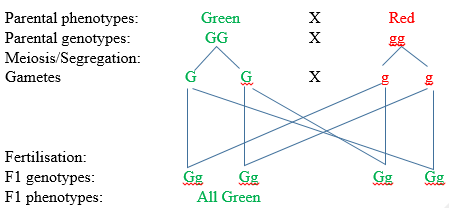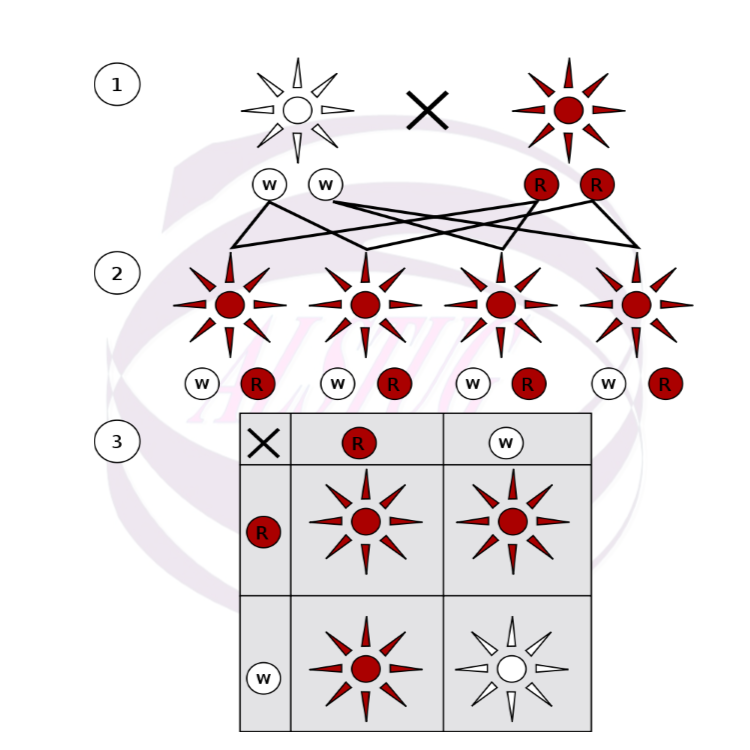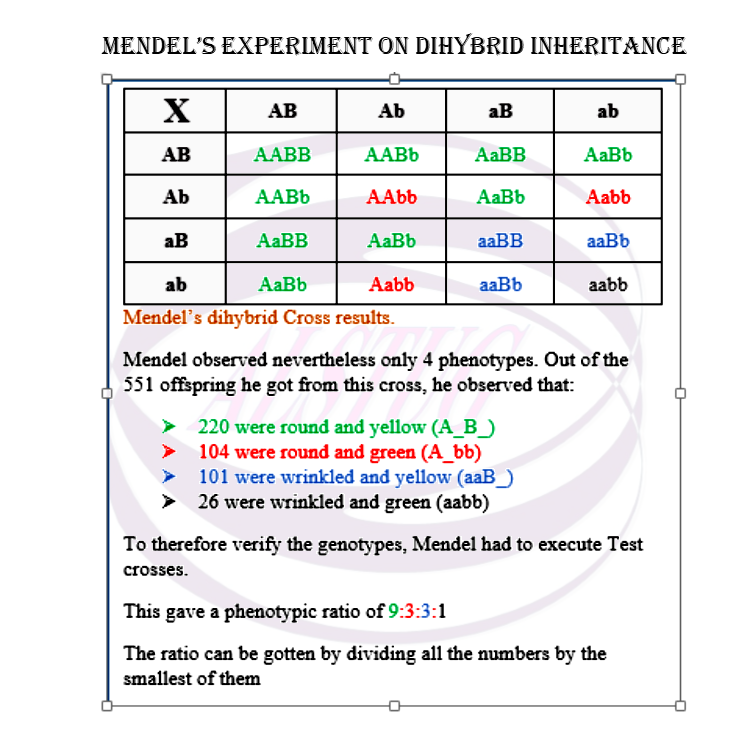MENDELIAN GENETICS
Mendelian Genetics refers to genetics that obeys the “Mendel’s laws of genetics”. Yes, the very fact that Mendel studied organisms for seven years gives him the right and capacity to establish laws. The laws established by Sir. Gregor Mendel are the foundation blocks for the understanding of non-Mendelian crosses.
MENDEL'S LAWS OF GENETICS
The laws stipulated by mendel are cruicial in the study of genetics. Mastering them is crucial. What therefore are these laws?
-
The law of Dominance:
This is also called Mendel’s first law of inheritance. According to the law of dominance, hybrid offspring will only inherit the dominant trait in the phenotype. The alleles that are suppressed are called the recessive traits while the alleles that determine the trait are known as the dominant traits. During crosses or drawing of genetic diagrams the dominant allele is represented by a capital letter while the recessive allele is represented by a lower case letter e.g. Aa or AA or aa.
If we may take an example, let’s assume that for hair length in guinea pigs, long hair is dominant over short hair. According to this law, in any case where an allele for long hair is present, the individual will have long hair. Hence, an individual will only have short hair if both alleles for the gene are of short hair. This is actually the definition of the recessive allele (an allele that is expressed only in the homozygous state).
-
The law of Independent assortment:
Also known as Mendel’s second law of inheritance, the law of independent assortment states that a pair of traits assort independently of another pair during gamete formation. As the individual heredity factors assort independently, different traits get equal opportunity to occur together.
In putting things plainly, let’s assume two (2) characteristics which genetic representations; Aa, and Bb. According to this law, the gene Aa is inherited in accordance to the first law above without considerations of the gene Bb and vice versa.
-
The law of Segregation:
The law of segregation states that during the production of gametes, two copies of each hereditary factor segregate so that offspring acquire one factor from each parent. In other words, allele (alternative form of the gene) pairs segregate during the formation of gamete and re-unite randomly during fertilization. This is also known as Mendel’s third law of inheritance.
All the above laws exist due to precise studies. Now, the first law of inheritance (law of dominance) was created due to monohybrid crosses. Examples:
EXAMPLE 1.
When a pure breeding bean plant with green pods was crossed with another pure breeding bean plant with red pods, all the offspring produced had green pods. The offspring were allowed to self-pollinate and the following results were obtained, 428 bean plants had green pods while 152 had red pods. Explain the genetics of the crosses using appropriate diagram and symbols.
Solution
We must first understand the question. Pure breed here means only one type of allele is present. Also, if a hybrid (offspring of parents with contrasting phenotypes) has only one of the phenotypes then one is dominant.
Answer:
Let the allele for green pods be G and Let the allele for red pods be g or
Let the dominant allele for pod colour be G and the recessive allele for pod colour be g.

Below, is a picture showing a similar cross on a Punnet Square. Execute a similar cross to that on the punnet square below (F1 generation self-pollinate). Also execute a test cross only in the punnet square and compare your results with mine:
Results of test cross: 2 Green : 2 Red

MENDEL’S EXPERIMENT ON DIHYBRID INHERITANCE
First, he produced plants that were purebred for the traits he wanted to examine. Using the combination of the pea’s shape and colour, for instance, he selectively bred pea plants until the offspring always had round, yellow seeds. These plants were homozygous dominant for both traits. He then bred plants that were homozygous recessive for both seed shape and colour. These individuals always had wrinkled, green seeds. Mendel then performed a dihybrid cross; that is, he crossed two pea plants that differed in two traits (pea shape and pea colour). The F1 generation all had round, yellow seeds. Remember that round seed shape and yellow colour are dominant characteristics. The offspring were therefore all heterozygous for the two traits. If A represents the dominant trait for pea shape and B represents the dominant trait for pea colour, the genotype of the F1 generation is AaBb. The phenotype is round and yellow seeds. What happens if you cross individuals of the F1 generation? Observe the figure below containing the Punnet square.

It is important to note that Mendelian genetics has a total monohybrid sample space of 4 while the total dihybrid sample space is 16.
EXAMPLE 2:
A male and a female guinea pig are both heterozygous for fur colour and fur texture. Both dark fur (D) and rough fur (R) are dominant traits.
- What are the recessive traits and what letters do you use for them?
- What are the parent phenotypes?
- How many different gametes are formed and what are they?
- Determine the frequency of offspring that are homozygous for both traits.
- Determine the frequency of offspring that have rough, dark fur.
- Determine the frequency of offspring that express both recessive traits.
Solutions:
1.
What are the recessive traits and what letters do you use for them? The recessive traits are coloured fur and smooth fur respectively. They will be represented by “d” (lower case D) and “r” (lower case R) respectively.
2.
What are the parent phenotypes? Both parents have dark and rough fur.
3.
How many different gametes are formed and what are they? Four different gametes are formed from both parents (but the gametes are the same in both parents). These gametes are DR, Dr, dR and dr.
4.
Determine the frequency of offspring that are homozygous for both traits. (This can only be done after you’ve produced the punnet square).
Frequency = number of favourable outcomes / total number of outcomes.
Number of double homozygous = 1DDRR + 1ddrr = 2.
Total outcomes = 16..
Frequency of double homozygous = 2/16 = 1/8.
5.
Determine the frequency of offspring that have rough, dark fur. (This can only be done after you’ve produced the punnet square).
Frequency = number of favourable outcomes / total number of outcomes.
Number of rough dark fured = 1DDRR + 8DdRr = 9.
Total outcomes = 16.
Frequency of double homozygous = 9/16.
6.
Determine the frequency of offspring that express both recessive traits. (This can only be done after you’ve produced the punnet square).
Frequency = number of favourable outcomes / total number of outcomes.
Number of double recessive = 1ddrr.
Total outcomes = 16.
Frequency of double homozygous = 1/16.
EXERCISE 2:
In people, curly hair is dominant over straight hair and the ability to curl the tongue is dominant over not being able to curl the tongue. A man with curly hair who has the ability to curl his tongue and a woman with curly hair who cannot curl her tongue have
children. What are the possible phenotypic ratios of their offspring? Find also the frequency of curly haired individuals and the frequency of straight hair and tongue curling individuals.
More exercises will be uploaded in Part 6.
You can equally find some in past Cameroon GCE Advanced and Ordinary level Biology Papers.
Find Cameroon GCE Ordinary level papers here.
Find Cameroon GCE Advanced level papers here.
Links to previous parts:
Note written by BUO GENESIS KELLY
You can interact with us and other mates on our Facebook group via the following link.
Please login to post comments.
No comments here